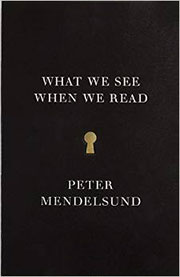 There is a new book out, What We See When We Read, by Peter Mendelsund [Vantage Books]. I have not read the book, only a review. But I shall read it. Because it tries to answer this question: When we read we see the words on the page. But, upon seeing the words, what do we picture in our minds? To quote from the [reviewed] book, “Words are effective not because of what they carry in them but for their latent potential to unlock accumulated experiences of the reader.”
There is a new book out, What We See When We Read, by Peter Mendelsund [Vantage Books]. I have not read the book, only a review. But I shall read it. Because it tries to answer this question: When we read we see the words on the page. But, upon seeing the words, what do we picture in our minds? To quote from the [reviewed] book, “Words are effective not because of what they carry in them but for their latent potential to unlock accumulated experiences of the reader.”
This is of huge importance to the writer, because it conveys, correctly, I believe, the enormous importance of word choice in everything one writes. Think of such basic, commonplace words such as “hate,” “violence,” “love,” or “friendship.” Since every reader presumably comes to these words with a different set of experiences, each reader will see these words differently.
There is another vital point, particularly for those of us who write for young people: if we adults come to a word loaded with experiences which let us see, what about children who one supposes have less experience, less vocabulary—how do they see a word?
My own view, for what it is worth, is that this reminds us that the way we construct our sentences and paragraphs is vital to help the reader—particularly the young reader—to see the word in the context we—writers—wish them to be seen.
Famously, Gustave Flaubert, the 19th Century French novelist, sought “le mot juste” (translated as “the right word”) when he wrote. Well, yes, more power to the word. Hurrah for the sentence. But … long live the beautiful paragraph—the ones that let us see the words as experience.
6 thoughts on “Le mot juste”
In The Art Institute of Chicago part of the curriculum is to require the students to write essays about their reasoning behind every piece of art they create. The essays have to communicate intention and desired outcome. Although interpretation can’t be controlled, students learn that they MUST have reasons and meanings behind their art. They must COMMUNICATE something, even in commercial pieces. I think its an amazing practice. It teaches creatives to do things on purpose.
Thanks for the book recommendation. Totally putting it on my Goodreads!
Another lovely post. Thanks for sharing, and your generosity in sending out the bookplates to the non-winners. My family and I were excited to get the mail and feel like winners now! We look forward to the new book.
The smallest units of writers’ building blocks.
And in the beginning there was the WORD.
It’s also the name of the program I’m using to type this.